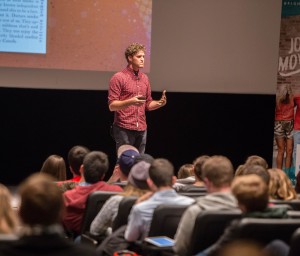
Fight the New Drug, an anti-pornography organization, urged BYU students to join its movement against pornography in the Joseph Smith Building auditorium on Friday, Nov. 14.
The auditorium filled with a steady stream of students. Among those students, communications major Trent Martinez said he came because of the interesting subject topic.
“It’s a taboo subject because people think it’s awkward,” Martinez said. “But it’s cool to be open about it. It’s hardly talked about outside of church, but it’s so prevalent.”
Melissa Richardson, Andrew Dixon and Cory Cooper, of the BYU Unraveling Pornography Club, introduced the presentation. Richardson, who is also serving as Miss Provo, has made fighting against pornography one of her major stances.
The presentation began with a quick video detailing decision-making and how it effects society. The video described how pornography flooded the worldwide web when Internet access began to be normalized.
Clay Olsen, one of the founders of Fight the New Drug, spoke about the core message of the presentation. “If you take one message home with you today, I hope you remember that pornography is harmful and research has proven it,” he said.
Olsen opened his presentation by talking about how slow science is to catch up with truth. As an example, an ad flashed across the screen for cocaine toothache drops from March 1885. Since this date, we’ve learned that cocaine is harmful. “We learn and move on,” he said.
Next, a tobacco ad that said “More Doctors Smoke Camels” came up on the screen. Olsen said everybody was smoking during the mid 20th century, including doctors, because science had not yet caught up with truth that smoking is harmful.
“We’re learning a similar lesson in our history regarding pornography. We now know through study and research that pornography not only harms our brain. It harms the brain, the heart and the world,” Olsen said.
Olsen explained that pornography and its effects are now in the media more than ever. There’s an explosion in public interest because research is catching up, he said.
Then Olsen described “The Four As” of pornography:
- Accessible
- Affordable
- Anonymous
- Addictive
Olsen and his friends began researching and finding science that supports the fact that pornography harms users. They asked the question, “Why is nobody talking about this in a way younger people can understand?”
This instigated Fight the New Drug, an anti-porn organization with the mission to change the way people look at pornography — especially young people.
“If we can impact them before it’s too late, we can make a big impact,” Olsen said.
Olsen and his partners began a website and started doing presentations at schools. The organization grew, and with that growth, Olsen said, they began to see a craving for truth. With that craving came thousands of emails from teenagers and adults telling of their struggles.
Thirty percent of the emails they received came from women.

“This is crossing all boundaries. Pornography doesn’t discriminate,” Olsen said.
One email from a 17-year-old boy said, “I feel like it’s affecting my motivation to do other things in life. I also feel it contribute to my lack of willpower.”
Olsen continued by outlining three categories: Porn is addictive, porn kills love and porn harms society.
He first talked about how pornography affects the brain by rewiring the reward pathway.
“When you do something you enjoy, pleasure chemicals release and it makes you feel good. It makes you want to repeat that. Those same chemicals release when you’re doing not-so-cool things, like drugs. It hijacks the reward path and can literally rewire the brain,” he said.
To feel the same effects, viewers require more doses and higher intensities. This is true of drugs and pornography.
“Over time, through prolonged exposure and addiction to pornography, your frontal lobes of your brain can shrink,” Olsen said.
The frontal lobe is where one determines pros and cons in situations. “It’s no wonder addicts have a hard time stopping; that part of their brain has been altered, rewired,” Olsen said.
The next area Olsen described is how porn affects the heart and relationships, specifically, unrealistic expectations, objectification and disordered sexual templates.
“Pornography is always available, always ready and always novel. It’s completely catered to satisfying your individual desires. Often times when individuals report back from being married, they say they can’t feel satisfied through their partner — they’re more satisfied through pornography,” he said.
Pornography changes the sexual template. Because what an individual watches can shape who and what they’re attracted to, Olsen explained that pornography can develop an unhealthy and warped sexual template in users.
Pamela Paul, author of “Pornified,” said “men who use pornography say they are losing the ability to relate to, be close to, and achieve orgasm with real women.”
The last section Olsen explained was how pornography effects the world.
He said the nature of pornography has changed. It’s no longer the Playboy that parents think of when they define pornography. Research was displayed on the screen with a quote from Ana J. Bridges of the University of Arkansas. The quote read, “Physical violence against women is in 88% of porn films.”
“This is changing things in a big way, and if we don’t do anything about it, the world we hand off to our kids is going to be much different,” he said.
Olsen said porn is linked to sex trafficking. He said in a lot of cases, people are beaten, drugged and forced into participating in the production of pornography because of demand.
He concluded by returning to the core of his presentation. He repeated that “porn is affecting our brains, our hearts and our core.”
Olsen encouraged those struggling with pornography to head to the organizations’s recovery website, Fortify, that is geared toward helping those with addictions overcome them.
When he asked the audience who was going to help change the world by fighting pornography, every hand in the Joseph Smith Building auditorium rose.




